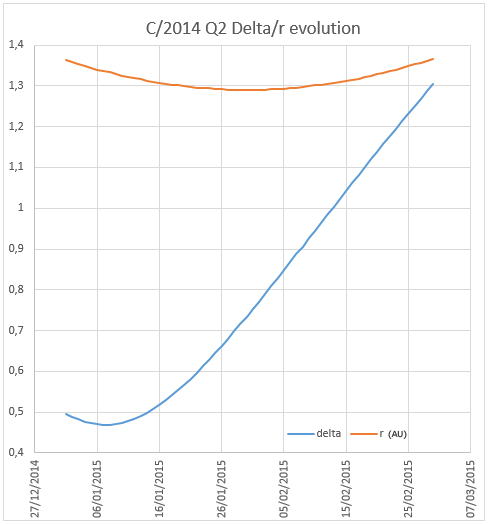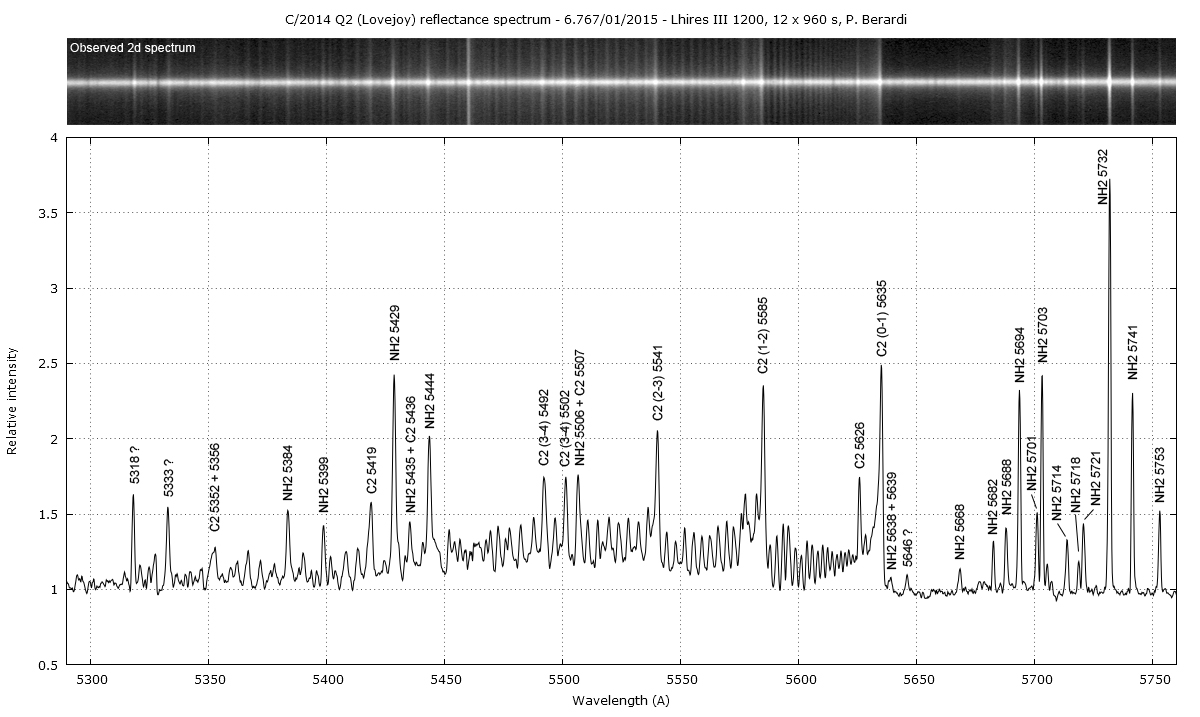C2014Q2
-
Joan Guarro Flo
- Posts: 712
- Joined: Thu Nov 03, 2011 8:50 pm
C2014Q2
To all:
I attached this graphic of the C2014 Q2 of last night.
I think it was worth observing to see how it evolves.
Happy New Year, Joan.
I attached this graphic of the C2014 Q2 of last night.
I think it was worth observing to see how it evolves.
Happy New Year, Joan.
-
Paolo Berardi
- Posts: 578
- Joined: Thu Sep 29, 2011 10:51 pm
Re: C2014Q2
Hi Joan, that's an excellent spectrum, spectrograph in Santa Maria observatory works very fine!
I'm trying some mid-res (Lhires III 1200) observation and I'm finding what spectrum parts are interesting to study. Comet shows the "standard" molecular bands (carbon C2 Swan band, C3, NH2, perhaps CH) but I don't know if we can find any interesting atomic lines. By now comet has reach perihelion (at end of january) and sun distance varies only a few between today and perihelion date (1.34 against 1.29 AU). If there are not special events (like an outburst) perhaps the spectrum will not change much.
Here the r and Delta values from now to end of february

Delta, the distance from the observer to the object (in AU)
r, the distance from the sun to the object (in AU)
When I reduce spectra I show you results.
Ciao!
Paolo
I'm trying some mid-res (Lhires III 1200) observation and I'm finding what spectrum parts are interesting to study. Comet shows the "standard" molecular bands (carbon C2 Swan band, C3, NH2, perhaps CH) but I don't know if we can find any interesting atomic lines. By now comet has reach perihelion (at end of january) and sun distance varies only a few between today and perihelion date (1.34 against 1.29 AU). If there are not special events (like an outburst) perhaps the spectrum will not change much.
Here the r and Delta values from now to end of february

Delta, the distance from the observer to the object (in AU)
r, the distance from the sun to the object (in AU)
When I reduce spectra I show you results.
Ciao!
Paolo
-
Joan Guarro Flo
- Posts: 712
- Joined: Thu Nov 03, 2011 8:50 pm
Re: C2014Q2
Ciao Paolo:
I think it is worthwhile to continue observing the comet C2014Q, if we do spectroscopy of comet, people of ARAS. Who will?
It may also be that there is some surprise.
Since you teach your results.
Saluti tanti, Joan.
I think it is worthwhile to continue observing the comet C2014Q, if we do spectroscopy of comet, people of ARAS. Who will?
It may also be that there is some surprise.
Since you teach your results.
Saluti tanti, Joan.
-
Francois Teyssier
- Posts: 1565
- Joined: Fri Sep 23, 2011 1:01 pm
- Location: Rouen
- Contact:
Re: C2014Q2
There's an interesting article in Astronomical Spectrography for Amateurs
"Cometary Spectroscopy" by Nicolas Biver
François
"Cometary Spectroscopy" by Nicolas Biver
François
François Teyssier
http://www.astronomie-amateur.fr
http://www.astronomie-amateur.fr
-
Francois Teyssier
- Posts: 1565
- Joined: Fri Sep 23, 2011 1:01 pm
- Location: Rouen
- Contact:
Re: C2014Q2
Olivier Thizy joined Nicolas Biver
"Je pensais justement qu'il était temps d'inviter les amateurs a tenter la
spectro sur cette comète qui est sans doute la meilleurs occasion de ces
dernières années: brillante, maintenant bien placée dans le ciel et très
gazeuse (peu de poussières apparemment). En plus côté pro on commence à
s'activer car son dégazage n'arrête pas de monter (maintenant plus de
6tonnes d'eau par seconde, à 1.35 UA du Soleil cela commence à faire pas
mal!)"
Here's the text from Nicolas about Cometary Spectroscopy
English : http://www.astronomie-amateur.fr/Docume ... et2010.pdf
Français : http://www.astronomie-amateur.fr/Docume ... et2010.pdf
Of course, we build an page on Aras and data base
So send spectra to christian and me
François Teyssier
Tonight "I am CHARLIE"
"Je pensais justement qu'il était temps d'inviter les amateurs a tenter la
spectro sur cette comète qui est sans doute la meilleurs occasion de ces
dernières années: brillante, maintenant bien placée dans le ciel et très
gazeuse (peu de poussières apparemment). En plus côté pro on commence à
s'activer car son dégazage n'arrête pas de monter (maintenant plus de
6tonnes d'eau par seconde, à 1.35 UA du Soleil cela commence à faire pas
mal!)"
Here's the text from Nicolas about Cometary Spectroscopy
English : http://www.astronomie-amateur.fr/Docume ... et2010.pdf
Français : http://www.astronomie-amateur.fr/Docume ... et2010.pdf
Of course, we build an page on Aras and data base
So send spectra to christian and me
François Teyssier
Tonight "I am CHARLIE"
François Teyssier
http://www.astronomie-amateur.fr
http://www.astronomie-amateur.fr
-
Paolo Berardi
- Posts: 578
- Joined: Thu Sep 29, 2011 10:51 pm
Re: C2014Q2
Hi Joan, François and all,
yes, we should observe it... but weather must agree!
François, thank you for documents about comets. I see your topic just now, when I wrote my post. Asap I'll read them with interest. I hope to find other information about spectral lines.
Yesterday I observed the comet with Lhires III 1200. The R~5000 profile includes wavelengths from 5285 to 5765A. I'd like to arrange a larger interval with several observations (weather permitting).
In the same observing session I took separate spectra for sky background and solar light (the Moon spectrum), then a reference star for general response.
False nucleus region and close coma (reflectance spectrum):

I put some labels for strongest lines (I hope they are ok). It is not easy for me to identify faint lines due to the density of the emissions in some of bands. Also difficult to understand which emission lines are the continuation of these bands. I could not identify three lines at about 5318A, 5333A and 5646A. If you can find something about, please let me know. In a 2005 paper (Frozen Hydrocarbon Particles of Cometary Halos as Carriers of Unidentified Emissions, Irakli Simonia) I found a 5318A wavelength coincidence with a Chrysene molecule C18H12 but I don't know if it is effectively in relation.
Some intermediate steps during data reduction:
Observed spectrum:

Sky background spectrum:

Observed - sky background:

Moon spectrum:

Reflectance spectrum (observed sky removed / Moon):

Paolo
yes, we should observe it... but weather must agree!
François, thank you for documents about comets. I see your topic just now, when I wrote my post. Asap I'll read them with interest. I hope to find other information about spectral lines.
Yesterday I observed the comet with Lhires III 1200. The R~5000 profile includes wavelengths from 5285 to 5765A. I'd like to arrange a larger interval with several observations (weather permitting).
In the same observing session I took separate spectra for sky background and solar light (the Moon spectrum), then a reference star for general response.
False nucleus region and close coma (reflectance spectrum):

I put some labels for strongest lines (I hope they are ok). It is not easy for me to identify faint lines due to the density of the emissions in some of bands. Also difficult to understand which emission lines are the continuation of these bands. I could not identify three lines at about 5318A, 5333A and 5646A. If you can find something about, please let me know. In a 2005 paper (Frozen Hydrocarbon Particles of Cometary Halos as Carriers of Unidentified Emissions, Irakli Simonia) I found a 5318A wavelength coincidence with a Chrysene molecule C18H12 but I don't know if it is effectively in relation.
Some intermediate steps during data reduction:
Observed spectrum:

Sky background spectrum:

Observed - sky background:

Moon spectrum:

Reflectance spectrum (observed sky removed / Moon):

Paolo
-
Christian Buil
- Posts: 1432
- Joined: Mon Sep 26, 2011 6:59 pm
- Contact:
Re: C2014Q2
Paolo, impressive spectrum!
(Can you indicate your source for lines identification)
For all observers, do not hesitate to transmit to me and François your processed spectrum for an ARAS compilation (the objet is famous and so publication is possible). christian.buil-at-wanadoo.fr
I am Charlie !
-----------------------
Très impressionnant spectre Paolo, très détaillé !
Pour tous les observateurs, ne pas hésiter m'envoyer vos spectres pour archivage sur le site ARAS (cet objet est majeur et donc, il y a toujours possibilité de publication)
Je suis Charlie !
(Can you indicate your source for lines identification)
For all observers, do not hesitate to transmit to me and François your processed spectrum for an ARAS compilation (the objet is famous and so publication is possible). christian.buil-at-wanadoo.fr
I am Charlie !
-----------------------
Très impressionnant spectre Paolo, très détaillé !
Pour tous les observateurs, ne pas hésiter m'envoyer vos spectres pour archivage sur le site ARAS (cet objet est majeur et donc, il y a toujours possibilité de publication)
Je suis Charlie !
-
Paolo Berardi
- Posts: 578
- Joined: Thu Sep 29, 2011 10:51 pm
Re: C2014Q2
Thanks Christian! Most of information come from:
A High-Resolution Catalogue of Cometary Emission Lines
M.E. Brown, A.H. Bouchez, H. Spinrad, and C.M. Johns-Krull
Astronomical Journal, 112, 1197-1202, 1996
http://web.gps.caltech.edu/~mbrown/comet/echelle.html
I am Charlie!
A High-Resolution Catalogue of Cometary Emission Lines
M.E. Brown, A.H. Bouchez, H. Spinrad, and C.M. Johns-Krull
Astronomical Journal, 112, 1197-1202, 1996
http://web.gps.caltech.edu/~mbrown/comet/echelle.html
I am Charlie!
-
Olivier Thizy
- Posts: 370
- Joined: Sat Sep 24, 2011 10:52 am
- Location: in the french Alps...
- Contact:
Re: C2014Q2
Paolo,
Very nice spectrum of the comet - a great work! More to come on this comet I'm sure...
In this hard environment, I wish you all best wishes for this New Year 2015. Let's finish it better than it started in Paris...
Je suis Charlie.
Cordialement,
Olivier
Very nice spectrum of the comet - a great work! More to come on this comet I'm sure...
In this hard environment, I wish you all best wishes for this New Year 2015. Let's finish it better than it started in Paris...
Je suis Charlie.
Cordialement,
Olivier
Olivier Thizy
https://observatoire-belle-etoile.blogspot.fr/
https://observatoire-belle-etoile.blogspot.fr/
-
David Boyd
- Posts: 164
- Joined: Wed Dec 11, 2013 5:50 pm
Re: C2014Q2
Spectrum of C2014 Q2 Lovejoy taken on 6th January at an altitude of 33 degrees on the meridian. Total integration time 110 min.
Best regards, David
Best regards, David